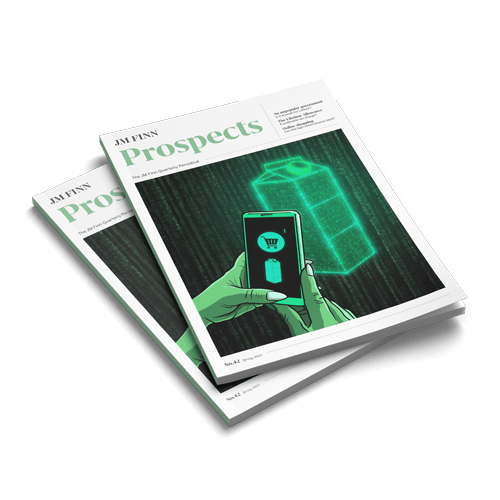Technology has undoubtedly altered the way in which we shop and will continue to augment physical retail shopping in order to improve the customer experience and/or reduce operational costs. The internet hurt physical retail by driving up price transparency (how many times have you googled the online price of a product whilst in store?) and providing near limitless choice from the comfort of the living room – a highly convenient and effortless experience.
Yet, although it has grown rapidly in recent years, it might surprise you to learn that e-commerce sales in the UK account for just c.30% of total retail sales¹; physical retail retains the lion’s share.
E-commerce sales in the UK account for just c.30% of total retail sales.
Evidently physical retail is ceding market share on a fairly consistent trend rate of approximately one percentage point per year. The COVID pandemic certainly didn’t help as e-commerce gained share via mandated lockdowns that forced vast numbers of consumers online out of necessity. Looking back allows us to see how UK footfall declined over -80% at various points in 2020 and 2021 versus pre-pandemic 2019 comparator levels. As of December 2022, UK footfall had staged a meaningful recovery; less than -10% below its 2019 level². However, this raises the question of how might physical retail improve its competitiveness to mitigate market share losses?
A number of retail surveys have suggested that consumers are actually willing to pay more for a product they can buy and collect immediately. This presents an opportunity for physical retailers or omni-channel retailers; those with both an online and offline presence. For physical retailers to excel in this area they need to ensure stock availability. Products need to be available on the shelf each and every time so that customers have high levels of confidence in their ability to fulfil a purchase transaction. This requires particular focus to be placed on technologies to improve inventory management. Meanwhile, omni-channel retailers may benefit from improving click and collect services. Greater focus on mobile-first digital design could prove increasingly valuable to reflect the broad consumer shift to mobile devices. Plus, greater flexibility around reserving or purchasing products ahead of time for pick-up in physical stores may boost satisfaction. Such measures would seem to reduce the primary focus away from price by enhancing the customer experience and hence, the value-add proposition offered by physical retail stores.
For online retailers, a growing challenge has been the increase in logistics complexity alongside the rise in shipping and delivery costs juxtaposed against a growing base expectation from consumers for ‘free delivery’ services and, easy returns processes. These issues, I believe, have worsened over the past few years and undermined the profitability of pure play online fashion retailers like Boohoo and ASOS. Competitor fashion retailers with less complex hub (warehouses) and spoke (physical stores) distribution setups could improve store and transport utilisation rates by incentivising customers to exclusively pick up, or return, orders to stores. This footfall pull strategy provides additional customer marketing opportunities and scope to better use existing fixed cost assets.
Management consultancy, McKinsey, recently provided their vision of retail shopping in 2030, outlining an increasingly personalised shopping experience driven by high levels of data analysis that could seek to go as far as tailoring the sounds and smells of the shopping experience. While I admire the forward thinking potential of data analysis, I think physical retailing should seek a bifurcated offering.
E-commerce gained share via mandated lockdowns that forced vast numbers of consumers online out of necessity.
At the high end there seems great potential to become increasingly personalised and experiential where flagship stores delight customers with unique products, brand history and skilled craft. Skincare brand, Aesop for example, are developing highly immersive store emporiums that encourage consumers to visit, bring family and friends and, test the latest skincare products in a relaxed and inviting setting.
At the mass market end, convenience and efficiency may need greater focus. A clear technology driven opportunity for physical retail is checkout-less stores. Aldi are piloting their checkout-less supermarket, Aldi Shop&GO, in Greenwich. Shoppers enter the store after having downloaded a smartphone app which stores their payment details. The shopping experience begins by scanning a QR code from the app on an entrance turnstile. Shoppers then select products from around the store, add them into their bags before simply walking out. A receipt miraculously appears in the app later that day. The experience is seamless from the consumer perspective which could reinvigorate footfall and, retailers no longer need labour resource at the tills helping to cut store staffing costs.
Consumers are willing to pay more for a product they can buy and collect immediately.
Computer vision is the exciting technology enabling checkout-free shopping and it could offer up revitalisation potential for physical retail. Computer vision is an area of artificial intelligence (AI) that uses algorithms and large volumes of training data to enable computers to recognise objects within images by breaking down image frames into pixels, which are then labelled by the computer to calculate the probabilistic likelihood of an image reflecting a certain object. This technology has the potential to provide a meaningfully better and more frictionless consumer experience that should help encourage people back into stores. Grocery shopping is a fairly repetitive task for consumers and queuing at the tills is seen as one of many pain points; the aggregate removal of multiple pain points improves the experience and lessens the pull to grocery shop online.
Overall I think e-commerce will continue taking share from physical retail but gains may moderate as the benefits of online retail have become more universal and competition has intensified. Physical retailers, meanwhile, have been under pressure and forced to adapt to better meet changing customer needs. Ahead, there seem to be growing pockets of opportunity in physical retail to delight consumers focused around physical product interactions or by removing traditional pain points. That might just hold the key to rejuvenating the outlook for physical retail.
¹ International Trade Administration: www.trade.gov/country-commercial-guides/united-kingdom-ecommerce
² Redburn
Illustration by Asa Taulbut





